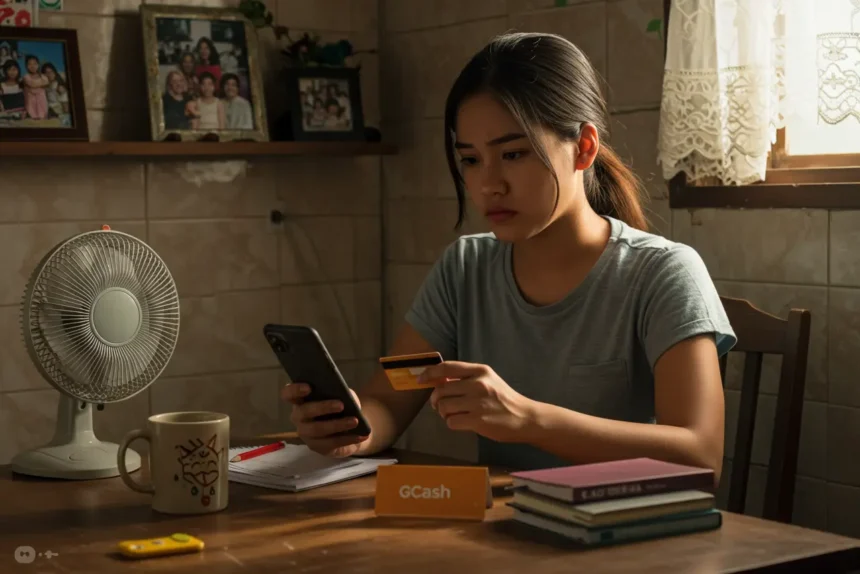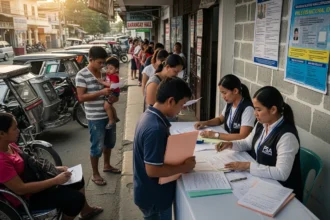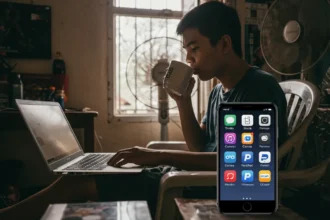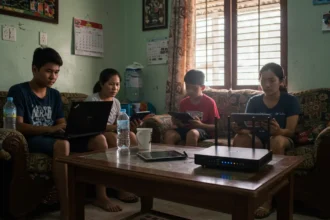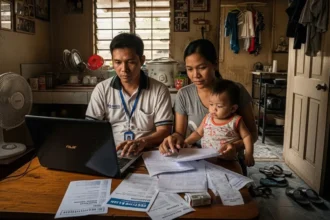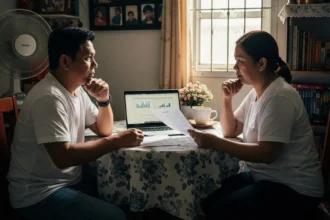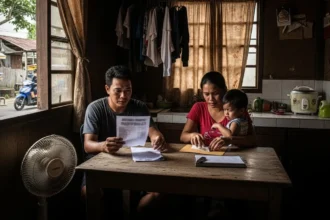We all love a good online deal. Who wouldn’t? A new pair of shoes for half the mall price, or a “branded” bag that looks straight out of Greenbelt but costs less than your kuryente bill. Online shopping feels like a jackpot machine – exciting, convenient, and sometimes, too tempting to resist.
- 🚩 1. Prices Too Good to Be True
- 🚩 2. No Seller Reviews or All Fake-Looking Reviews
- 🚩 3. Asking for Advance Payment via Sketchy Methods
- 🚩 4. No Clear Product Photos or Stolen Images
- 🚩 5. Suspicious Communication Style
- 🚩 6. No Official Store or Verification Badge
- 🚩 7. Too Many Complaints on Online Forums or Social Media
- ✅ Bonus Section – How to Shop Safely Online in the Philippines
- ❓ FAQs About Spotting Fake Sellers Online
- 🛡️ Action Recap – Shop Smart, Stay Scam-Free
- 🧭 References
But here’s the catch: not every seller on your screen is who they claim to be. For every legit tindero, there’s a scammer waiting to make a quick buck off unsuspecting buyers. One wrong click, and your hard-earned sweldo flies out the window with nothing to show for it.
That’s why spotting the red flags of fake online sellers is a must-have skill for today’s Pinoy shopper. Think of this as your digital street-smart guide: the kind that helps you enjoy the bargains, without getting burned.
🚩 1. Prices Too Good to Be True
Scammers know one thing very well: Pinoys can’t resist a “steal” of a deal. That’s why the first bait they throw out is rock-bottom pricing. And honestly, sino ba namang hindi matetempt sa offers like these:
- A ₱20,000 smartphone suddenly “on sale” for ₱5,000.
- Branded sneakers worth ₱6,000 in the mall, sold for ₱799 only.
- A 55-inch smart TV offered for ₱3,500 – shipping pa lang, lugi na sila.
Sounds amazing, right? But that’s the trick. Fake sellers rely on buyers who act fast, thinking they’ve found a jackpot, without stopping to question the logic.
The truth? Legit discounts exist – but usually during big sale events (Shopee 11.11, Lazada Birthday Sale) and still within a reasonable range. A ₱1,500 item might drop to ₱999, sure. But an 80–90% cut on a hot item, especially from a random seller with no track record? That’s a scammer’s calling card.
What you should do:
- Compare the item’s price across different sellers and official stores. If one shop is drastically lower, magduda ka na.
- Think of logistics: shipping, tax, and supplier cost. If the seller’s price makes no business sense, it’s not a deal – it’s a trap.
- Remember: scammers rely on impulse. Take a minute to pause, research, and ask yourself – “If this was real, wouldn’t everyone be buying it already?”
👉 Bottom line: a real bargain saves you money, a fake one costs you everything. Don’t let “mura” blind you into ignoring common sense – because once the scammer has your cash, wala na, goodbye na.
🚩 2. No Seller Reviews or All Fake-Looking Reviews
One of the best things about shopping on legit platforms like Lazada or Shopee is the review section. Real buyers will usually leave photos, ratings, and honest feedback – both good and bad. If a seller has zero reviews despite offering “hot” items, that’s a big red flag.
Scammers also try to fake it by planting reviews that look… well, suspicious. Watch out for these signs:
- Reviews that are overly generic: “Good item. Fast delivery.” repeated over and over.
- All 5-star ratings posted on the same day (fishy, right?).
- Reviews with stock or stolen product photos instead of actual customer shots.
- No “bad” reviews at all – which is unrealistic for any shop.
And it’s not just on Lazada or Shopee. On Facebook Marketplace, a seller with no visible history, no past activity, or a profile created just last month is a risk. Real sellers usually have a digital “footprint” – posts, friends, groups, even old profile pictures. If everything looks brand new or empty, that’s a clue you’re dealing with a fly-by-night account.
What you should do:
- Always read reviews before buying. Look for photo reviews and comments about shipping time, packaging, and product quality.
- Be cautious of sellers who turn off the “review” or “comment” feature.
- On FB Marketplace, check the seller’s profile age and activity. The newer and emptier it looks, the riskier the deal.
👉 Final thought: a trustworthy seller leaves digital breadcrumbs – reviews, comments, feedback. A scammer? They leave nothing but deleted accounts and frustrated buyers.
🚩 3. Asking for Advance Payment via Sketchy Methods
Here’s one of the oldest tricks in the scammer playbook: “Pay first, ship later.” On the surface, it sounds normal – a lot of legit sellers ask for pre-payment too. But the difference lies in how and where they want you to pay.
Scammers almost always push for direct, untraceable payments like:
- GCash transfers to a personal account with no business name.
- Bank deposits under a random individual (not a registered company).
- Money remittance centers (Palawan, Cebuana) sent to someone you’ve never met.
Once the money is sent, goodbye na. No item, no refund, no seller – just a blocked account and a lesson learned the hard way.
Meanwhile, legit platforms (Shopee, Lazada, Zalora, etc.) offer protection via their wallets and COD (cash on delivery) systems. Your payment is only released to the seller once the product is confirmed delivered. That’s why fake sellers prefer sidestepping these protections – they want your cash instantly.
Real-world example:
- On Facebook Marketplace, you see an iPad for ₱7,000. The seller insists, “GCash niyo muna, hindi ako nagpapadala ng COD.” You send it, and they promise to ship “tomorrow.” Next day? Account deleted.
- Another classic: a seller who says, “Pa-reserve po, kailangan ng downpayment.” This “downpayment” is their exit strategy.
What you should do:
- Avoid direct GCash/bank transfers unless it’s a trusted shop you already know.
- Stick to COD or platform-secured payments whenever possible.
- If a seller insists on sketchy payment methods, that’s your cue to walk away.
👉 Remember: convenience should never come at the cost of security. If the seller can’t accept safe payment options, that’s not a bargain – that’s a scam in waiting.
🚩 4. No Clear Product Photos or Stolen Images
A legit seller wants to show off their product. A scammer? They’d rather hide behind blurry stock photos or grab images straight from Google.
Here’s what to watch for:
- Stock images only – The same polished product shot you’ve seen on ten other listings. (Legit sellers usually add their own pics, even if medyo sabog ang lighting.)
- Too-perfect photos – Branded sneakers shot on a white studio background? Unless it’s from an official store, that’s suspicious.
- No “in-hand” photos – Real sellers often take a picture with the item on their table, bed, or even their kamay for proof.
- Watermarked or mismatched pics – If you spot a different shop’s watermark, or photos that don’t match the item being sold, that’s a giveaway.
Example scenarios:
- A “brand new” gaming laptop on FB Marketplace uses the exact same photos from an official Asus website. No box shots, no charger photos, no real-life angles. Suspicious agad.
- A Shopee seller listing cheap perfume, but every picture is a glossy ad photo. No actual bottle in sight. Chances are, fake or no item at all.
What you should do:
- Always ask for actual item photos. A trustworthy seller will happily snap a quick picture with today’s date written on paper beside it.
- Reverse search the image (via Google Lens). If the same picture pops up on multiple sites, it’s probably stolen.
- Be skeptical if they dodge requests for new photos or send you more of the same stock images.
👉 Bottom line: if you can’t see the real item, assume it doesn’t exist. Scammers love hiding behind borrowed pictures, because once the truth is revealed, wala na – it’s too late.
🚩 5. Suspicious Communication Style
Sometimes, you don’t even need to see the product – the way the seller talks to you is already a giveaway. Scammers often slip up in their communication style because they’re more focused on rushing the deal than building trust.
Red flags to watch out for:
- Rushing you to decide: “Last stock na po!” or “Magbabayad na yung isa, pa-reserve na lang kung GCash niyo ngayon.” Pressure tactics = classic scammer move.
- Vague or evasive answers: Ask for the product’s specs or condition, and they reply with “Legit yan sis, promise.” But no details.
- Poor grammar or generic replies: Of course, not all typos mean scam. But if every answer feels copy-pasted or robotic, that’s suspicious.
- Avoiding video calls or meetups: If you suggest to meet in a mall or request a quick video of the product, they’ll either ghost you or make excuses.
Examples:
- You ask a seller on FB Marketplace: “May resibo ba ito?” Instead of answering, they say, “Yes ma’am, legit to.” – pero walang sagot sa resibo.
- A Lazada chat with a “seller” ends with, “Pls GCash only. No COD.” The moment you ask for proof pics, seen-zoned ka na.
What you should do:
- Legit sellers answer questions directly – they know the product they’re selling.
- If a seller avoids giving clear details or keeps pressuring you to pay, that’s your cue to stop.
- Trust your gut. If something feels “off” in the way they respond, it probably is.
👉 Bottom line: honest sellers talk to you like a customer, scammers talk to you like a target.
🚩 6. No Official Store or Verification Badge
One of the easiest ways to filter legit sellers from fakes is to look for verification marks. On big platforms, they’re practically giving you clues – but many buyers still ignore them.
On Lazada and Shopee:
- Official brands usually carry the “Mall” or “Official Store” badge. These sellers go through extra verification, so they’re far less likely to scam.
- Fake shops, on the other hand, often set up generic names like “Best Gadget PH” or “Super Discount Shop.” No badge, no history, just promises.
On Facebook Marketplace:
- Most scammers hide behind newly created accounts – zero friends, no timeline history, and sometimes even stock photos for their profile pic.
- Legit small-time sellers (yung mga kapitbahay nagbebenta ng preloved items) usually have active profiles: posts, groups, family photos, or at least signs they’ve been around for a while.
What you should do:
- On Shopee/Lazada, stick to “Mall” stores when buying big-ticket items. For smaller sellers, check their join date and reviews.
- On FB Marketplace, scan the profile. If the account was made last month and has no activity? That’s a red flag.
- Always ask: does this seller have something to lose if they scam you? If not, be extra cautious.
👉 Quick rule: the less visible the seller, the easier it is for them to vanish. If there’s no badge, no profile history, and no accountability – they can ghost you the moment you pay.
🚩 7. Too Many Complaints on Online Forums or Social Media
Here’s the thing: scammers can delete accounts, but they can’t erase their bad reputation. If you take five minutes to Google their shop name, number, or even GCash account, you’ll often find a trail of angry buyers who’ve been duped before.
Where to check for red flags:
- Facebook groups & community pages – Pinoys love warning others. You’ll often see posts like “Scammer alert: don’t buy from this seller, nawala after payment.”
- Shopee/Lazada reviews – Look beyond the 5-star reviews. The 1- or 2-star feedback often reveals delays, fake items, or orders never delivered.
- Online scammer databases – Some watchdog sites and FB communities keep updated scammer lists with names, numbers, and screenshots.
- Google Search – Just type the seller’s name or phone number + the word “scam.” If multiple complaints pop up, huwag mo na ituloy.
Examples:
- You find a PS5 for ₱10,000 on FB Marketplace. A quick search of the seller’s number shows multiple posts on forums like, “Beware, he scammed me too.”
- A Shopee store selling “authentic” branded perfumes has dozens of reviews saying “Fake, don’t buy.” But the shop’s cover photo screams “SALE SALE SALE.” That’s the tell.
What you should do:
- Always do a quick background check before big purchases.
- Don’t just rely on what the seller shows you – look at what other buyers are saying.
- Treat repeated complaints as proof. Where there’s smoke, there’s fire.
👉 Bottom line: if many buyers already waved the red flag, believe them. Don’t think you’ll be the “lucky exception” – you’ll just be the next victim.
✅ Bonus Section – How to Shop Safely Online in the Philippines
Okay, so we’ve covered the red flags. But let’s flip the script – how do you actually shop safely online, lalo na dito sa Pinas where scams are all over? Here are some tried-and-tested tips:
- Stick to platforms with buyer protection. Shopee, Lazada, Zalora, and other big e-commerce sites usually hold your money until the item is confirmed delivered.
- Use COD or platform wallets when possible. Cash on delivery is safer than sending money straight to a stranger’s GCash.
- Always screenshot transactions. From chat messages to payment confirmations – these can help if you need to file a complaint.
- Don’t rush. Scammers thrive on panic and urgency. Take a breather before clicking “Pay.”
- Check the seller’s digital footprint. Reviews, activity, badges, even social media presence. A legit seller leaves traces.
👉 Safe online shopping isn’t about paranoia, it’s about awareness. Think of these habits as your digital seatbelt – simple steps that save you from big headaches later.
❓ FAQs About Spotting Fake Sellers Online
Q1: What should I do if I already paid a fake seller?
Report the incident immediately to the platform (Shopee, Lazada, etc.) or GCash/bank if you transferred money. File a complaint at your local barangay or police cybercrime unit with screenshots as evidence.
Q2: Is cash-on-delivery (COD) always safe?
Safer, yes – but not 100%. Some scammers ship fake or empty items just to collect COD. Always inspect the parcel before fully accepting it.
Q3: How do I know if Shopee or Lazada sellers are legit?
Check for the “Mall” or “Official Store” badge. For smaller shops, look at reviews with photos, ratings, and store age.
Q4: Are Facebook Marketplace sellers riskier?
Yes, kasi walang built-in buyer protection. You deal directly with individuals. Check their profile history, ask for meetups in public places, and avoid full prepayments.
Q5: What are common GCash scams from sellers?
Asking you to transfer money before shipping, sending fake receipts, or pretending to be from a legit shop. Always double-check the account name and avoid sending to personal numbers you don’t know.
Q6: Can fake sellers also target buyers with fake delivery riders?
Yes. Some scams involve riders delivering “pay on delivery” items that turn out empty or fake. Inspect the package carefully before paying.
Q7: How can I report fake sellers in the Philippines?
Through the platform (Shopee/Lazada “Report Seller” option), or for FB sellers, report the profile and post. You can also file with the PNP Anti-Cybercrime Group or DTI Consumer Protection.
Q8: What signs prove a seller is trustworthy?
Consistent positive reviews, clear item photos, willingness to answer questions, and safe payment options. Some even provide receipts or warranty cards.
Q9: Are there apps or tools to help verify sellers?
Yes. Use Google Lens to check if product images are stolen, or search GCash/bank numbers in scammer databases and FB groups. Community feedback is powerful.
Q10: Should I avoid buying big-ticket items online completely?
Not necessarily. Buying gadgets, appliances, or luxury items online can be safe if you stick to official stores or authorized resellers. For random unverified sellers? Avoid – better to buy from known outlets.
🛡️ Action Recap – Shop Smart, Stay Scam-Free
Online shopping can be one of the best conveniences of modern life – but only if you’re smart about it. Scammers thrive on excitement, panic, and impulse buys. That’s why spotting the red flags is your first line of defense.
Quick recap of what to watch out for:
- 🚩 Prices that are too good to be true.
- 🚩 Zero or fake-looking reviews.
- 🚩 Sketchy payment demands.
- 🚩 Stock or stolen product photos.
- 🚩 Sellers who dodge questions or rush you.
- 🚩 No official store badge or profile history.
- 🚩 Complaints piling up online.
Pair these with safe shopping habits – like using COD, checking reviews, and trusting your gut – and you’ll cut your chances of getting scammed dramatically.
At the end of the day, every peso counts. Don’t let it slip away to scammers. Stay alert, be street-smart online, and keep those deals legit so you can enjoy the perks of digital shopping without the heartbreak.
🧭 References
-
Respicio PH – Online Seller Scam Remedies Philippines
-
Pressable – How to Minimize WooCommerce Order Fraud



